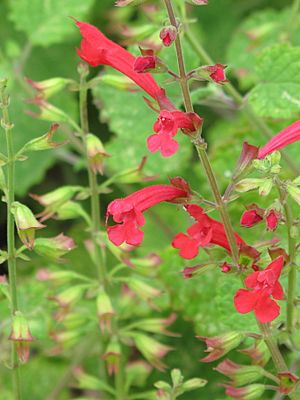Cedar sage facts for kids
Quick facts for kids Cedar sage |
|
|---|---|
 |
|
| Scientific classification |
Salvia roemeriana is a beautiful wild plant known by its common names, cedar sage or 'dwarf crimson-flowered sage'. This plant is a type of shrub that lives for many years. It grows back each spring after dying down to the ground in winter. You can find cedar sage growing naturally in Texas, especially in an area called the Edwards Plateau. It also grows in parts of Arizona and several areas in Mexico.
The name roemeriana was given to honor a German geologist named Ferdinand von Roemer. He lived in Texas for a few years in the 1840s and is known as the "father of Texas geology" because of his important work studying the state's rocks and land. The common name, cedar sage, comes from the "cedar brakes" or cedar forests where this plant often grows. It also likes to grow in oak forests and on rocky areas. People started growing cedar sage in gardens in 1852. A famous garden writer, William Robinson, really liked it for its neat look. He suggested using it as a border plant or at the front of garden beds.
Contents
What Does Cedar Sage Look Like?
Cedar sage is a small plant, usually growing up to about 1 foot (30 cm) tall and wide. It spreads easily by dropping many seeds, which helps it form large groups or "colonies" of plants. Its leaves are a fresh, grassy green color.
Flowers and Stems
One of the best things about cedar sage is its bright, scarlet red flowers. These flowers grow in groups called "whorls" on tall stems that stand above the plant. These flower stems can be 8 to 10 inches (20 to 25 cm) tall. Each plant can have many of these flower stalks, making it look very colorful when it blooms.
Where Does Cedar Sage Grow?
Cedar sage is native to specific regions in North America. It thrives in areas with certain types of soil and climate.
Native Regions
- Texas: Especially common in the Edwards Plateau region.
- Arizona: Found in some parts of this state.
- Mexico: Grows in several provinces.
This plant prefers to grow in places like cedar forests, oak woodlands, and rocky areas. It's quite adaptable to different conditions within its native range.

